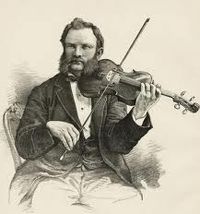Annotation:Queen's Welcome to Invercauld (The): Difference between revisions
No edit summary |
No edit summary |
||
| Line 4: | Line 4: | ||
'''QUEEN'S WELCOME TO INVERCAULD, THE.''' Scottish, Marching Air. A Mixolydian. Standard tuning (fiddle). AABB. Composed by [[Biography:J. Scott Skinner]]. The march was included as one of the tunes in his 1921 concert set romantically entitled "Warblings From the Hills." | '''QUEEN'S WELCOME TO INVERCAULD, THE.''' Scottish, Marching Air. A Mixolydian. Standard tuning (fiddle). AABB. Composed by [[Biography:J. Scott Skinner]]. The march was included as one of the tunes in his 1921 concert set romantically entitled "Warblings From the Hills." | ||
[[File:skinner.jpg|200px|thumb|left|J. Scott Skinner]] | [[File:skinner.jpg|200px|thumb|left|J. Scott Skinner]] | ||
The castle of Invercauld, Braemar, Aberdeenshire, has been the seat of Clan Farquharson chiefs since the 16th century. The present structure was redone in 1874 in the Scottish baronial style, with the front entrance re-oriented to face Balmoral in recognition of the new owners, the Queen of England, Victoria, and her husband Albert. It was the 12th Laird of Invercauld who played host to Victoria at the time. Famous Highland games (the Braemar Gathering) are held there yearly, although in 1848 they were delayed until September to allow Queen Victoria, coming to Balmoral for the first time, to attend. | |||
<br> | <br> | ||
<br> | <br> | ||
| Line 14: | Line 14: | ||
</font></p> | </font></p> | ||
<p><font face="garamond, serif" size="4"> | <p><font face="garamond, serif" size="4"> | ||
''Printed sources'': Skinner ('''The Scottish Violinist''', with variations), 1900; p. 31. Skinner ('''Harp and Claymore'''), 1904; p. 42. | ''Printed sources'': Skinner ('''The Elgin Collection'''), 1884. Skinner ('''The Scottish Violinist''', with variations), 1900; p. 31. Skinner ('''Harp and Claymore'''), 1904; p. 42. | ||
<br> | <br> | ||
<br> | <br> | ||
Revision as of 04:44, 16 February 2013
Back to Queen's Welcome to Invercauld (The)
QUEEN'S WELCOME TO INVERCAULD, THE. Scottish, Marching Air. A Mixolydian. Standard tuning (fiddle). AABB. Composed by Biography:J. Scott Skinner. The march was included as one of the tunes in his 1921 concert set romantically entitled "Warblings From the Hills."

The castle of Invercauld, Braemar, Aberdeenshire, has been the seat of Clan Farquharson chiefs since the 16th century. The present structure was redone in 1874 in the Scottish baronial style, with the front entrance re-oriented to face Balmoral in recognition of the new owners, the Queen of England, Victoria, and her husband Albert. It was the 12th Laird of Invercauld who played host to Victoria at the time. Famous Highland games (the Braemar Gathering) are held there yearly, although in 1848 they were delayed until September to allow Queen Victoria, coming to Balmoral for the first time, to attend.
Source for notated version:
Printed sources: Skinner (The Elgin Collection), 1884. Skinner (The Scottish Violinist, with variations), 1900; p. 31. Skinner (Harp and Claymore), 1904; p. 42.
Recorded sources:
